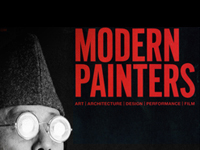
by Reuel Golden
Paola Ventura’s remarkable dioramas, which evoke a strange and often imaginary past, are conceived and created on two very ordinary tables at his Brooklyn studio. An Italian expat, Ventura deals with his homesickness by presenting memories, in turn coherent and fragmented, from his own past and his country’s. For Ventura, the past is not just something to be remembered, but also something to be interpreted and manipulated, very much like the action figures that dominate his photographs. He notes, “You can really have fun with the past.”
Whereas his 2006 series “War Souvenir” was time specific-it dealt with the impact of Fascism on a small town in 1930s Italy-his recent work, “Winter Stories,” is more nebulous. The recurring theme is a faded carnival that has come to town. The somewhat morose clowns, harlequins, and tightrope walkers could be from any era of the 20th century, and the setting is more generic European, rather than specifically Italian. One inspiration is the Roman painter Antonio Donghi, who flourished in prewar Italy and often depicted clownlike figures who were far from mirthful. One can’t help but also recall Fellini’s dirge to carnival life, La Strada.
Ventura’s “invented worlds.” As he refers to his work, start with notes or rough sketches of a particular scenario he has imagined. Once the concept is established, he then builds the set. The detail is extraordinary, from the folds in the clothes of the little figures, to the artfully arranged props, to the precise way the light and shadow play out in his pictures.
Yet surprisingly, he spends only a week to 10 days building the set, at an average cost of around $30. He uses foam board, cardboard, plastic, and wood-basically anything he can get a hold of. Asked where he got his handy skills, he laughs. “It’s a mystery,” he says. I was a disaster at everything in school. Originally, I set out to find things, but I soon realized I knew exactly what I wanted, so it would just be easier to make it myself.” He sometimes also buys props online from specialist dealers, his local Brooklyn flea market, and costume stores, and relies on a network of miniatures obsessives, who send him props they’ve made or collected.
Once the set is completed, Ventura takes Polariods to use as a reference for minor adjustments. He then shoots with a Pentax 6x7 camera from a fixed position, using only natural daylight, preferring to capture the scene on slightly overcast days. His happiest memories growing up in Milan were of winter mornings when the fog enveloped the city and distorted the commonplace. In each image, Ventura wants to create his own fog and blend the artifice with the “real.”
For instance, in the shot of the pilot sitting in the cockpit, the plane is a painted backdrop into which a model has been inserted. This contraption was a typical attraction that traveled to poor cities in postwar Europe and was the closest people got to flying. The “reality” of the scene is depicted in the glimpses of the street behind the backdrop. Incidentally, the pilot’s fetching leather jacket once belonged to a miniature figure of Hitler.
Ventura, 40, has been working on “Winter Stories” more or less solidly for the past two years, producing 49 images. He has also just completed a 12-print portfolio for a private collector who commissioned him to create a series on the wars in Iraq and Afghanistan. The work is more graphic and less ambivalent than “Winter Stories,” but equally compelling.
When asked about his next project, Ventura offers telling insight into his method: “My empty tables are like a canvas for a painter. I need to arrange things there to create.”